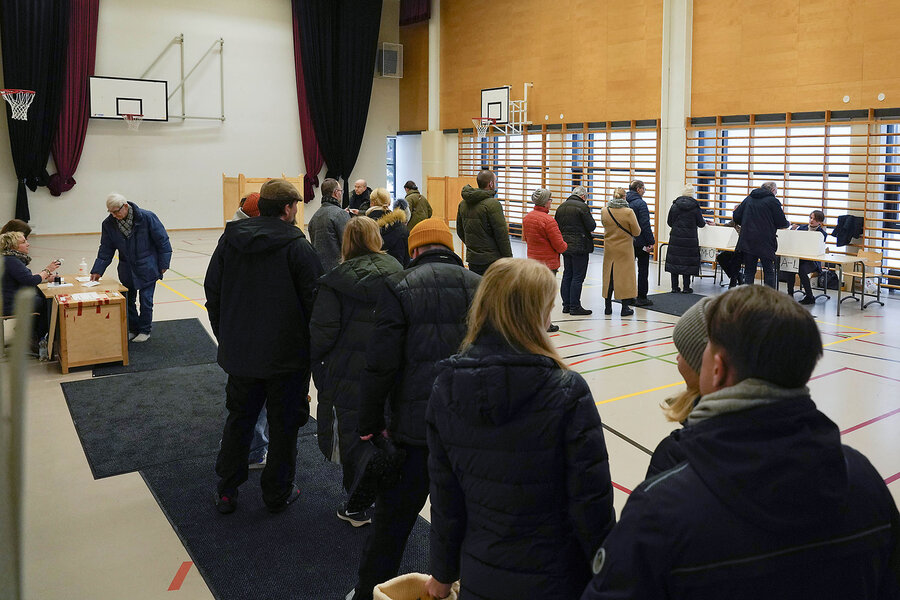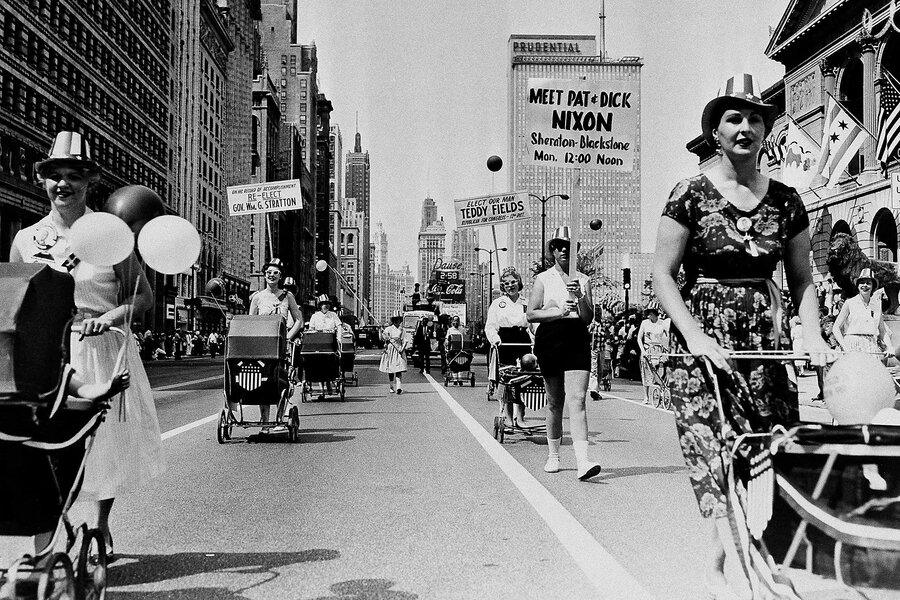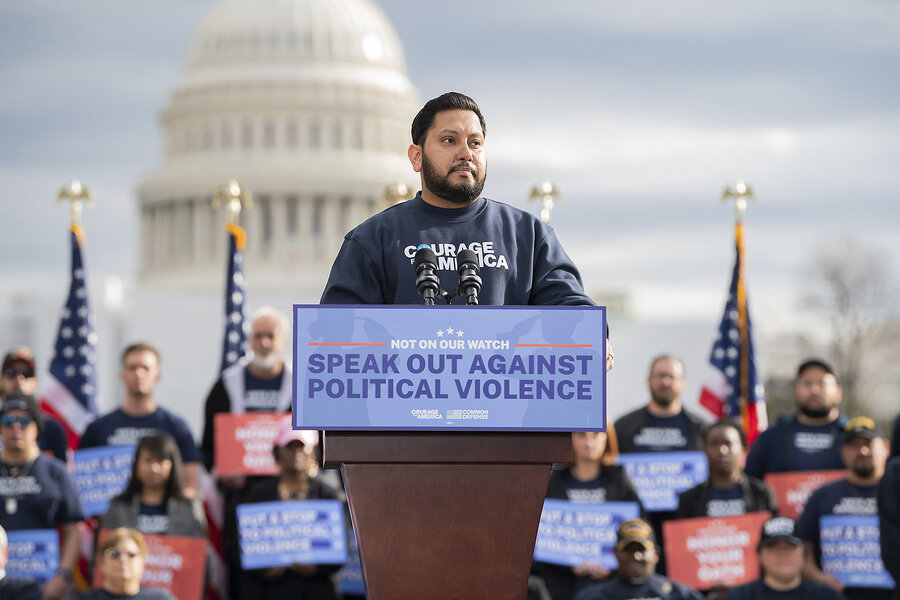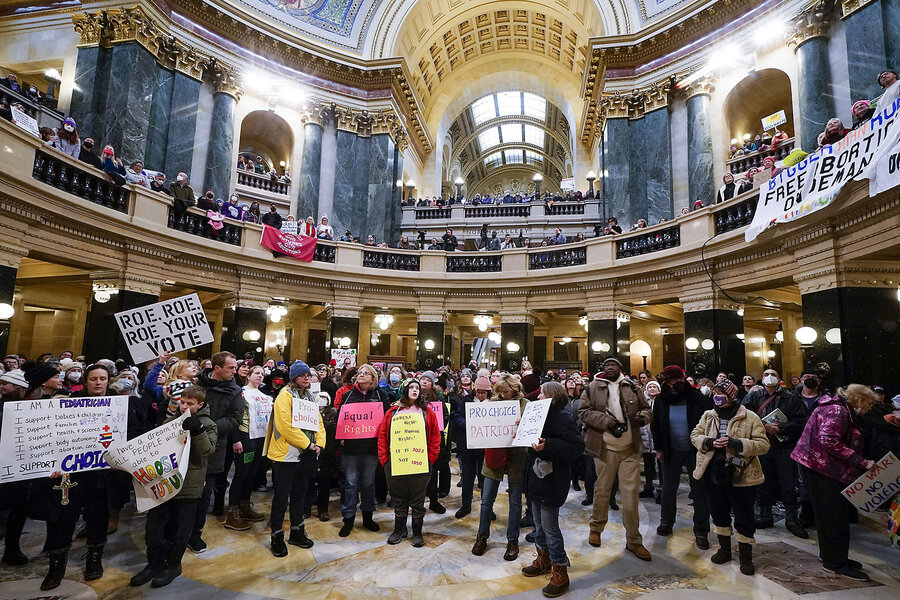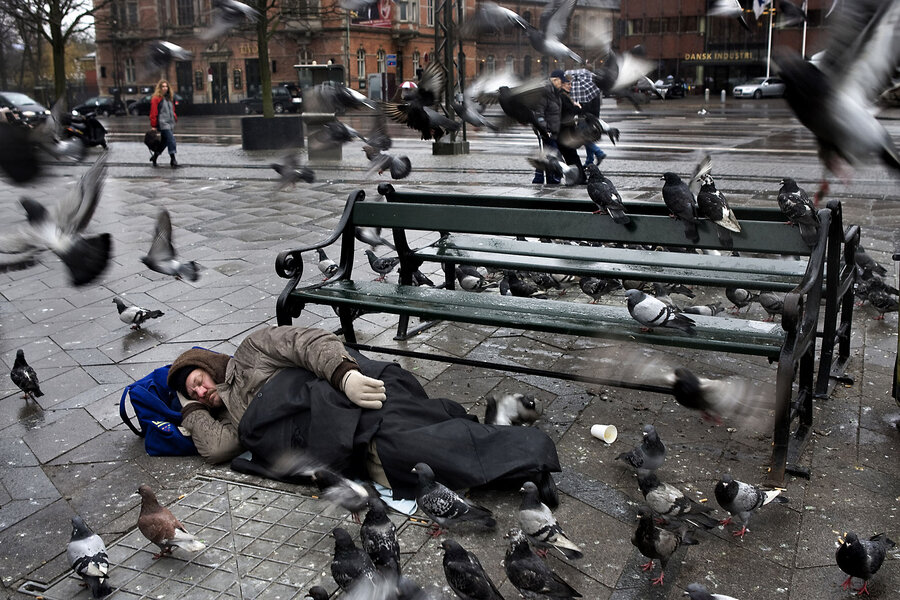What we think about trust and politics is (mostly) wrong
Loading...
When it comes to trust, we think we know the story. Trust in government is cratering. Polarization has driven Americans to hatred of those on the other political side and even to a new receptiveness to violence. And things seem to be only getting worse.
But that picture is not quite right. As is often the case, broad narratives lack nuance, and the media’s focus tends to accentuate the negative. The real story is both surprising and insightful, and it includes credible examples of communities and nations rebuilding trust.
Why We Wrote This
A story focused onWe all think we know the narrative about trust and politics, and it’s not good. But the real story is more complicated – and surprising.
So former Monitor Editor Marshall Ingwerson takes us on that journey. He lays out, point by point, what we know about the state of trust in the United States today and then widens the lens to see what can be learned from other places around the world.
Trust is the basic glue that binds civil society together – from driving safely through traffic to conducting business to Supreme Court rulings. It’s what keeps us respecting the rules even when we lose. Here, we offer a one-stop shop for understanding some of the biggest trends shaping the world today.
Pop quiz: Name this country.
It’s a presidential election year in one of the world’s richest and most advanced nations, high in political freedom and with a relatively democratic spread of incomes. Elections are very closely fought, but the vast majority of people believe most of their compatriots can be trusted to do the right thing most of the time, and they have strong confidence both in their news media and in their government.
Finland? Of course.
Why We Wrote This
A story focused onWe all think we know the narrative about trust and politics, and it’s not good. But the real story is more complicated – and surprising.
But this was also the United States in 1960.
The America of three generations ago had one of the world’s highest levels of social trust. Three out of 4 Americans in 1960 said they trusted the national government to do the right thing at least most of the time. And it wasn’t a partisan phenomenon. That was under a Republican president. But the trust level actually peaked at 77%, for both Black and white Americans, in 1964, when a Democrat was in the White House.
Could the U.S. ever reclaim that level of unity and of trust in government, trust in media, trust in key institutions, and trust in each other?
Certainly it would be a long climb. Last year, trust in government was at 16%, and it now has a deep partisan tilt. American trust is low across the board, but it’s two to three times lower among those whose favored political party does not occupy the White House.
In the current election season, Americans are divided not just over the candidates and political values they support, but over alternative realities. Was the 2020 election stolen, or was that very claim an attempt to steal it? Is the leading contender so corrupt and venal that he’s facing numerous felony trials (and civil suits) at once, or is the justice system so politicized that it has weaponized prosecutors to try to take him out?
On each side, the answers seem obvious, almost beyond dispute. What they both agree on is that their core values and rights are at risk and that democracy itself hangs in the balance.
Many scholars say that the American parties are as divided as they’ve been since the Civil War.
Over the course of our Rebuilding Trust project, the Monitor will look at trust through many different lenses. This article seeks to sketch a broad picture of the state of trust in public life in the U.S. and elsewhere in the world – and why it matters.
Understanding the trust problem
Let’s start with what’s not happening:
• Low political trust is not about President Joe Biden, and it’s not even about Donald Trump. Few politicians have ever had Mr. Trump’s instincts for making distrust and division work for him, and trust in government is near its lowest point now under Mr. Biden. Yet neither leader has moved the trend line much. Trust has bounced around the 20% level since the beginning of the Obama administration. It dipped to 15% in 2011, to 17% all the way back in 1994, and to 27% in 1980. It was from 1964 to 1980 – spanning the Johnson, Nixon, Ford, and Carter eras – that trust plummeted by two-thirds and never significantly bounced back.
• To a striking degree, partisan division in the U.S. is not about anything. Certainly, many Americans feel strongly about abortion rights, immigration, high prices, and many other issues. But the issues have become secondary for Americans who personally identify with the team that shares their basic values. Partisanship is increasingly personal, emotional, and negative – more about defeating the other team than, say, solving a national problem.
“If anything,” says Samara Klar, a political scientist at the University of Arizona in Tucson, “Democrats and Republicans overlap more than ever on the issues. But they’re more hostile to the other party.”
All this, political scientist Lilliana Mason wrote in an influential 2018 paper, “is likely to lead to a less compromise-oriented electorate. After all, if policy outcomes are less important than team victory, a policy compromise is a useless concession to the enemy.”
• Support for political violence is not nearly as high as most Americans think it is. A survey last fall found that 23% of Americans agreed that “patriots may have to resort to violence in order to save” the country. That included 33% of Republicans and 13% of Democrats. In the wake of the Jan. 6, 2021, storming of Congress, that may not feel like an idle threat.
But note that 27 years ago in 1997, the Pew Research Center did a massive study on political distrust in America and found that an even higher 27% said violence against the government could be justified. The political atmosphere may have changed since then, but it’s not clear that opinions about violence have shifted in decades.
And when these views are probed further, researchers find them vastly overstated. Sean Westwood, director of the Polarization Research Center at Dartmouth College, found in a 2022 study that support for violence was overestimated by a factor of six. He put the actual level at about 2.9%.
• Americans don’t have an accurate picture of people in the other party. When people picture partisans for the other side, they picture the most polarizing politicians. And political leaders have indeed become more partisan and extreme over the decades. “But have the people moved with them?” asks Yphtach Lelkes, a political scientist at the University of Pennsylvania. “The consensus is no.”
“Most Democrats and most Republicans are ideologically moderate,” says Dr. Klar. They are more concerned about the price of groceries, gas, and rent than inflamed by culture wars. But the most informed and engaged people tend to be the most partisan. And these are the people, says Dr. Klar, “that most people can’t stand.”
Americans also think the opposing party supports anti-democratic moves more than twice as much as it actually does, according to a 2022 study in the journal Proceedings of the National Academy of Sciences. When people are shown polling data that corrects this overestimate, their own support for anti-democratic measures drops by more than a third.
• Americans don’t actually hate people on the other side. Researchers have famously asked Americans if they would object to their children marrying someone from the other political party. In 1960, some 4% said they would object. In 2010, half of Republicans and a third of Democrats said they would be unhappy. Partisanship has become that personal.
But further studies have found that if the question specifies that the new in-law rarely talks about politics, then about half of the objection goes away. Many may in fact prefer an out-party in-law who leaves the subject alone to a same-party in-law who likes to talk politics. Though people really do cast a deep scorn on the other side’s political leaders and outspoken partisans.
• Americans overall and over time are not becoming more extreme or further apart on the issues. Yes, polls show Democrats and Republicans have moved further apart on issues from immigration to abortion. But this is less from people changing their positions and more about people changing parties. Parties used to be more ideologically blended, with conservative Democrats and liberal Republicans. But since the 1960s, conservatives have been migrating to the Republican fold and liberals to the Democratic camp. Party ranks are now more ideologically consistent, and distinct from each other.
• Americans are not losing trust across the board. Trust in local government is as high as it was in 1960. And it’s not just that it’s closer to home. In those days, trust in the federal government was actually higher than in local government. Trust in the military runs high in both parties and has actually risen in recent decades. Small business also has a high level of bipartisan confidence, in sharp contrast to big business and Big Tech.
• Eroding trust is not just an American problem. Most affluent countries are struggling with some degree of falling trust. But it’s not a universal problem, either. Denmark, Norway, Finland, the Netherlands, New Zealand, and Switzerland have been the most-trusted governments by their citizens for decades, and trust continues to run at very high levels.
• Lost trust does not have to stay lost. Ireland was a relatively high-trust country in its “Celtic Tiger” period before it plummeted in the financial crash of 2008. Since then, the share of Irish who say they are satisfied with their democracy has more than doubled and is now higher than before the crash.
• Even democratic decline is not an irreversible wave. On Jan. 14, Guatemala inaugurated a president popularly elected on an anti-corruption platform after months of assassination threats, the attempted arrest of his vice president-elect, and nonstop challenges to the legitimacy of the vote up to the day of inauguration. Guatemala is one of the most corrupt and dysfunctional governments in the world, and President Bernardo Arévalo doesn’t have many tools for changing that. But it’s a step.
A few weeks earlier, Donald Tusk returned to his former role as prime minister of Poland, which had been slipping in measures of democracy in recent years under the tight dominance of the Law and Justice party. The party had been steadily asserting greater political control over the judiciary branch as well as the news media. Mr. Tusk represents a coalition of more democratic parties that together outpolled Law and Justice in fall elections. This represents progress for European Union leaders worried about Poland’s direction.
What do high-trust countries look like?
Trust is the basic glue that binds civil society together – from driving safely through traffic and conducting business to ensuring that the military follows the orders of its unarmed civilian commanders and that Supreme Court rulings are not ignored. It’s what keeps us respecting the rules even when we lose.
Trust scholar Eric Uslaner of the University of Maryland, College Park defines social trust as “a belief that other people, especially people unlike yourself, are part of your moral community.”
Social trust is closely tied to optimism – the confidence that people can usually find a way to move forward against problems. And trust in government is closely tied to both. Some high-trust countries – such as China, Singapore, and Saudi Arabia – score low on democracy but high on economic progress over the past generation.
So what is different about highest-trust democracies?
• They have no high-level, systemic corruption. The top high-trust countries are a clean sweep of the top spots on Transparency International’s rankings of corruption as perceived by both the public and business leaders, with Denmark currently on top. The U.S. ranks 24th, down 10 places since 2000.
• They feel economically fair. The highest-trust countries are those with the highest levels of economic mobility – the ease of moving into higher or lower income groups. Denmark again tops the World Economic Forum’s Global Social Mobility Index, followed by the other Nordic countries, the Netherlands, and Switzerland. The U.S. ranks 27th. About 15% of children born to Danish parents in the poorest one-fifth of the population rise to join the highest-earning fifth. In the U.S., about 8% of children rise that far.
• They’re welfare states. These same countries have generous social safety nets. Denmark pays out about double what the U.S. does, per person, in public spending, not including military and debt interest. Denmark’s total tax burden as a share of gross domestic product is also nearly twice as high as the American. But surveys show that their citizens, more than anywhere else, have confidence in how their tax dollars are being spent.
• They have more than two political parties. “Two-party systems tend to breed conflict,” says Viktor Valgardsson of the University of Southampton in England. Multiple parties are forced to join coalitions with others to form governments and work out common ground.
“There is lots of evidence that multiparty countries have less polarization,” says Dr. Lelkes.
• Diversity may be a challenge. Their demographics are homogeneous and stable. Even in Belgium and Switzerland, which each is shaped by distinct language and cultural groups, the diversity is structured and long established. “They seem to function well,” notes Dr. Valgardsson.
But Americans have a much more dynamic population mix, growing by the year, in which non-Hispanic white people will no longer be a majority in about two decades. The largest immigrant group, Hispanics usually have more confidence in the U.S. government than either white or Black Americans. Asians tend to register higher trust as well. So the newest Americans appear to bring a slightly higher level of optimism with them.
Many lessons that the world’s high-trust nations may hold will not find an easy fit in the U.S. Scandinavians on average are liberal pragmatists who want a society that guarantees equality of opportunity and sets up safety nets for those in need, and surveys indicate they are largely getting what they want.
Americans think differently, explains Wayne Baker, a sociologist at the University of Michigan who has studied trust and values in a global context. They tend to prefer limited government, distrust authority, and hold strong, often moralistic, religious beliefs. Of all the high-income countries in the world, only Ireland and the U.S. are as grounded in traditional religious values. And unlike other religiously grounded countries, mostly poor or developing, the U.S. has robustly embraced the rich-country values of self-expression and personal fulfillment.
As a result of this tension, this nearly unique mix of traditional and progressive orientations, “Americans think about the meaning and purpose of life more frequently than in almost all economically advanced countries,” Dr. Baker says.
These days, Americans seem to be having a difficult, emotionally charged national conversation about the shape of their moral universe and who owes what to whom. Surveys would indicate that they don’t think they’re having it very productively. Maybe even counterproductively. The number who disapprove of both parties is at an all-time high. They’re not trusted, either.
The American experiment, says Dr. Baker, “is being sorely tested now. We’ve weathered major difficulties and differences before, and I think we will manage through this one, but it’s not inevitable that we will.”




